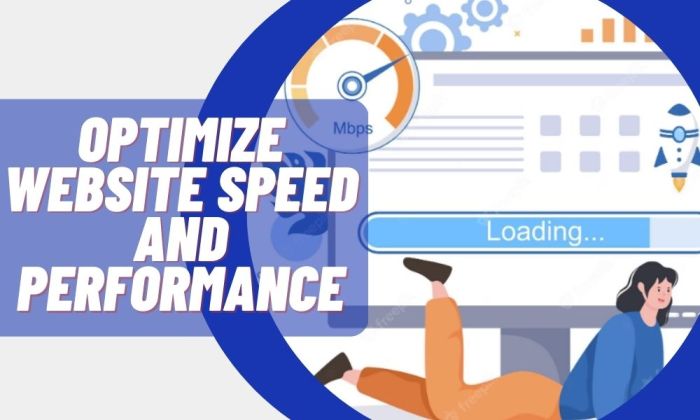Optimizing Website Speed is not just about loading times; it’s the key to unlocking a seamless user experience and boosting your site’s performance. Dive into the world of website speed optimization to discover how small tweaks can make a big impact.
Importance of Website Speed Optimization: Optimizing Website Speed
Optimizing website speed is crucial for user experience in today’s fast-paced digital world. Users expect websites to load quickly and efficiently, and if a site takes too long to load, they are likely to navigate away, resulting in a high bounce rate.
Faster loading times can also positively impact rankings. Search engines like Google prioritize websites that load quickly because they provide a better user experience. By optimizing website speed, you can improve your chances of ranking higher in search engine results pages (SERPs).
The relationship between website speed and conversion rates is significant. Studies have shown that even a one-second delay in page load time can lead to a decrease in conversions. By optimizing your website speed, you can provide a smooth and seamless experience for visitors, increasing the likelihood of them taking the desired action, whether it’s making a purchase, signing up for a newsletter, or filling out a form.
Factors Affecting Website Speed

When it comes to the speed of a website, several factors can impact how quickly it loads for users. From server performance to image sizes, each element plays a crucial role in determining the overall speed of a website.
Server Performance
Server performance is a key factor in website speed optimization. The speed at which a server responds to a user’s request can significantly impact how quickly a website loads. A slow server can cause delays in loading times, frustrating users and potentially leading to a high bounce rate. It is essential to ensure that the server hosting the website is reliable, has enough resources to handle incoming traffic, and is properly configured for optimal performance.
Image Sizes and Formats
The size and format of images used on a website can also affect loading times. Large, high-resolution images can slow down a website significantly, especially if they are not optimized for the web. It is crucial to resize and compress images before uploading them to a website to reduce their file size without compromising quality. Additionally, using the right image format, such as JPEG or PNG, can help improve loading times by ensuring efficient compression and rendering.
Strategies for Improving Website Speed

When it comes to optimizing website speed, there are several key strategies that can make a significant impact on the performance of your site. Let’s explore some of the most effective techniques below.
Minification of CSS, HTML, and JavaScript Files
Minification is the process of removing unnecessary characters and spaces from code without affecting its functionality. This helps reduce file sizes and improve loading times. By minifying your CSS, HTML, and JavaScript files, you can streamline the code and ensure that your website loads faster for users. Tools like UglifyJS, CSSNano, and HTMLMinifier can assist in this process.
Benefits of Browser Caching
Browser caching allows certain elements of your website to be stored locally on a user’s device after the initial visit. This means that when a user returns to your site, their browser can load cached resources instead of downloading them again. By leveraging browser caching, you can reduce server load and improve load times for returning visitors. Setting cache-control headers and utilizing tools like WP Rocket or W3 Total Cache can help you implement browser caching effectively.
Content Delivery Networks (CDNs), Optimizing Website Speed
Content Delivery Networks (CDNs) are a network of servers distributed across different geographic locations. By storing cached copies of your website’s files on these servers, CDNs help deliver content to users from the server that is closest to them physically. This reduces latency and improves loading speeds for users worldwide. Popular CDNs like Cloudflare, Amazon CloudFront, and Akamai can significantly enhance the performance of your website by distributing content efficiently.
Tools for Measuring Website Speed
When it comes to optimizing website speed, using the right tools is essential to track and improve performance. These tools provide valuable insights into how well your website is performing and what areas need attention.
Google PageSpeed Insights
- Google PageSpeed Insights is a popular tool for analyzing website speed and performance.
- It provides a detailed report on both mobile and desktop versions of your website, highlighting areas for improvement.
- By using Google PageSpeed Insights, you can identify specific issues affecting your website speed and take necessary actions to optimize performance.
Performance Metrics
- Performance metrics like Time to First Byte (TTFB) and First Contentful Paint (FCP) are crucial indicators of website speed.
- TTFB measures the time taken for the browser to receive the first byte of data from the server, reflecting server response time.
- FCP, on the other hand, measures how long it takes for the first content element to be rendered on the screen, indicating initial loading speed.
- Understanding and monitoring these metrics can help you gauge the overall performance of your website and make informed decisions for optimization.
Interpreting Results
- When using website speed testing tools like Google PageSpeed Insights, it’s essential to interpret the results correctly.
- Focus on areas marked for improvement and prioritize fixing issues that have the most significant impact on speed.
- Look for suggestions provided by the tool on how to address identified problems, such as optimizing images, leveraging browser caching, or minimizing server response time.
- Regularly test your website speed using these tools and track changes over time to ensure continuous improvement.





